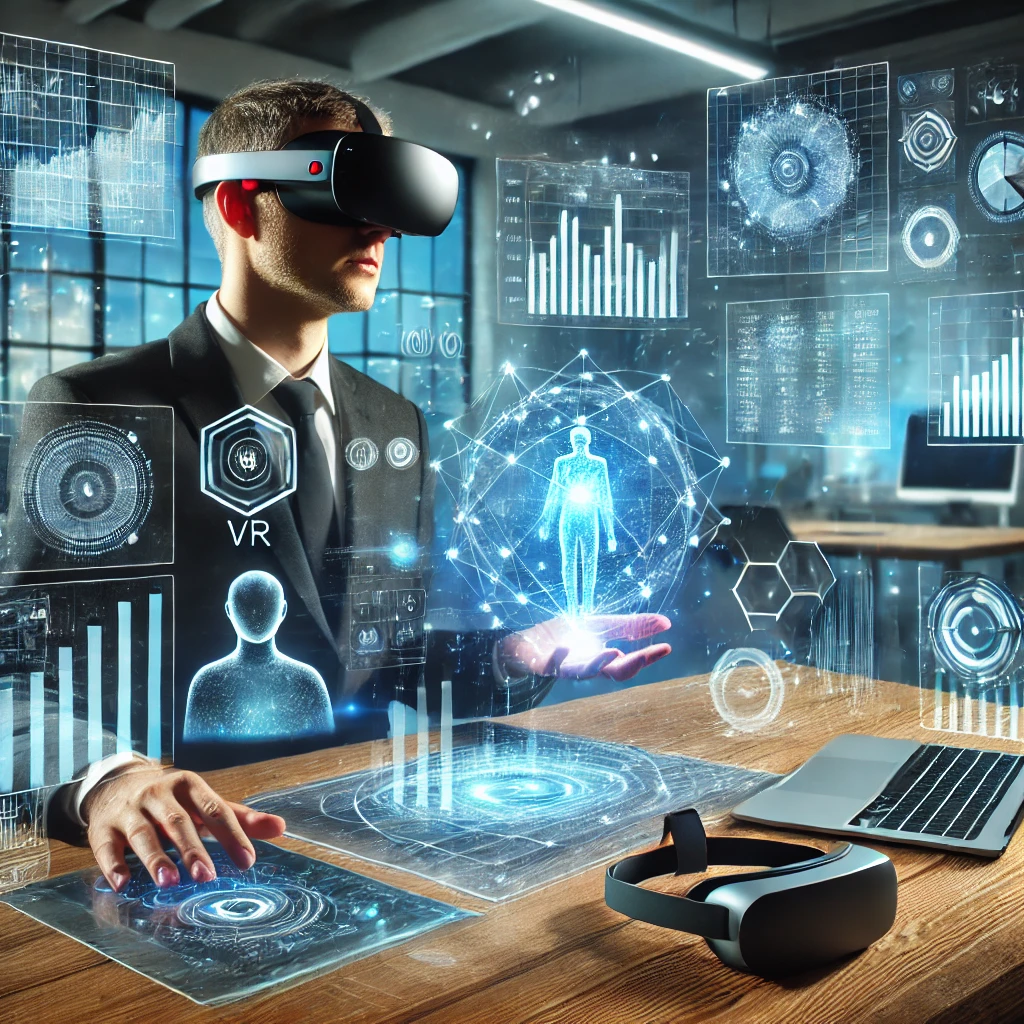Immersive technology is no longer just the stuff of science fiction. Virtual Reality (VR), Augmented Reality (AR), and Mixed Reality (MR) are rapidly becoming part of our daily lives, revolutionising how we work, learn, and interact. From virtual training environments to augmented retail experiences, immersive technology is reshaping industries in ways we couldn’t have imagined a decade ago.
Disclosure: If you click on my affiliate/advertiser’s links, I am going to receive a tiny commission. AND… Most of the time, you will receive an offer of some kind. It’ s a Win/Win!
I remember my first encounter with immersive technology—it was a clunky VR headset, and while the graphics were rudimentary, I could see its potential. Fast forward to today, and immersive tech is sleek, sophisticated, and packed with endless possibilities. The French saying “Qui ne tente rien n’a rien”—“Nothing ventured, nothing gained”—perfectly sums up why businesses and individuals are rushing headfirst into this transformative field.
In this article, we’ll explore what immersive technology is, how it’s changing industries, and how you can leverage it to stay ahead. Whether you’re an entrepreneur, an educator, or simply a curious innovator, there’s something here for everyone.
Points to be Discovered:
1. What Is Immersive Technology?
An introduction to VR, AR, and MR and their key differences.
2. The Business Applications of Immersive Technology
How companies are using immersive tools to innovate and grow.
3. Immersive Technology in Education
Explore how it’s enhancing learning experiences and skills development.
4. The Role of Immersive Tech in Healthcare
Discover its potential to revolutionise patient care and medical training.
5. Enhancing Retail and Customer Experiences
How brands are using AR and VR to engage customers like never before.
6. Workplace Training and Collaboration with Immersive Tools
Learn how immersive tech is transforming employee development and teamwork.
7. Immersive Technology for Entertainment and Gaming
From gaming to concerts, see how this tech is reshaping fun and leisure.
8. The Challenges and Limitations of Immersive Tech
Understand the hurdles businesses and users face in adoption.
9. Emerging Trends in Immersive Technology
Stay ahead with insights into what’s next for VR, AR, and MR.
10. Practical Tips for Embracing Immersive Technology
Actionable advice for incorporating immersive tech into your business or personal life.
11. Summary and Conclusion: Embracing the Future with Immersive Technology
1. What Is Immersive Technology?
Immersive technology refers to tools that create or enhance physical environments through virtual, augmented, or mixed realities. In simpler terms, it’s technology that makes you feel like you’re “in” the experience rather than observing it.
• Virtual Reality (VR): Fully immersive environments, like stepping into a video game or training simulation.
• Augmented Reality (AR): Overlays digital elements onto the real world, like trying on virtual clothes through your phone.
• Mixed Reality (MR): A hybrid of AR and VR, where virtual and real elements interact in real time.
What fascinates me most is how immersive tech bridges the gap between imagination and reality. It’s like the Finnish saying “Ajatus muuttuu todellisuudeksi”—“A thought becomes reality.” With the rapid advancement of hardware and software, immersive tech is making once-impossible ideas tangible.
Pro Tip: If you’re new to immersive technology, start small. Explore free AR apps on your smartphone to get a feel for how it works before diving into more advanced tools.
Start Your Business Today with Registered Agents Inc.2. The Business Applications of Immersive Technology
Businesses are embracing immersive technology to innovate, improve efficiency, and engage customers in unique ways.
• Product Design and Prototyping: Companies like Ford use VR to design cars, reducing costs and development time.
• Remote Collaboration: Tools like Spatial let teams collaborate in a virtual space, making remote work more dynamic.
• Marketing Campaigns: AR-powered campaigns, like IKEA’s app that lets customers visualise furniture in their homes, are game-changers.
I’ve seen businesses achieve incredible results with even basic AR tools. For example, one small fashion retailer I worked with added AR mirrors in-store, allowing customers to “try on” outfits virtually. Sales soared, and customer satisfaction improved.
Actionable Insight: Identify pain points in your business that immersive tech could address, like long development cycles or low customer engagement. Then, research tools that align with those needs.

3. Immersive Technology in Education
Education is one of the most exciting fields for immersive tech. Imagine learning history by walking through a VR simulation of ancient Rome or practising a surgical procedure through AR. Immersive technology doesn’t just teach—it immerses learners in an experience, making lessons unforgettable.
Studies show that VR can improve knowledge retention by up to 75% compared to traditional methods. For example, platforms like zSpace let students explore STEM concepts interactively, from dissecting virtual frogs to exploring physics principles.
The Swedish saying “Man lär så länge man lever”—“One learns as long as one lives”—feels especially true in this context. Immersive tech ensures that learning remains engaging and lifelong.
Pro Tip: If you’re an educator or trainer, start exploring affordable platforms like Google Expeditions for VR-based learning experiences.
Enroll in the AI Product Manager Nanodegree Program for a comprehensive overview of AI and machine learning for business. You'll learn to build and train AI models, evaluate results, and measure success. Click HERE to get started NOW.4. The Role of Immersive Tech in Healthcare
Immersive technology is revolutionising healthcare by improving patient care, training, and research. From virtual surgeries to patient therapy, VR, AR, and MR are enabling unprecedented advancements.
For example, VR training platforms like Osso VR allow surgeons to practise complex procedures in a risk-free, immersive environment. These tools have been shown to improve surgical performance by 230%! On the patient side, VR is being used for pain management, with studies indicating that virtual environments can reduce pain perception by up to 50%.
One inspiring example comes from AR-powered glasses used to assist visually impaired individuals. These glasses overlay real-time information to help navigate surroundings, offering newfound independence. The Hungarian saying “Az egészség a legnagyobb kincs”—“Health is the greatest treasure”—reminds us how life-changing these innovations can be.
Pro Tip: Healthcare professionals should explore partnerships with immersive tech companies to incorporate VR or AR into training programs or patient care initiatives.
The Frictionless Sales Engagement Platform for Revenue Teams. The world’s first all-in-one sales engagement platform that allows your sales team to engage more prospects and close more deals without software exhaustion.
Book a demo HERE
5. Enhancing Retail and Customer Experiences
Retailers are using immersive technology to redefine the shopping experience, blending the physical and digital worlds to create memorable interactions. AR apps like Sephora’s Virtual Artist let customers try on makeup virtually, while VR showrooms allow buyers to browse products in a fully interactive environment.
For example, furniture giant IKEA uses AR through its IKEA Place app, enabling customers to visualise how furniture fits in their homes. The result? Reduced returns and increased customer satisfaction. Smaller businesses are also catching on. A boutique clothing store I know introduced AR dressing rooms, which boosted in-store engagement and sales significantly.
The French saying “Le client est roi”—“The customer is king”—captures the importance of elevating the customer experience. Immersive tech is a surefire way to achieve that.
Actionable Insight: Even if you’re a small retailer, start with AR apps that let customers preview products. Many solutions are surprisingly affordable and easy to implement.
6. Workplace Training and Collaboration with Immersive Tools
Immersive technology is transforming workplace training by making it safer, more engaging, and more effective. Companies in industries like construction, aviation, and healthcare are using VR simulations to train employees in high-risk scenarios without actual danger.
Take Walmart, for instance, which uses VR to train staff on customer service and emergency preparedness. The results? Better retention rates and reduced training costs. Collaboration tools like Spatial and Microsoft Mesh are also enhancing teamwork, allowing remote teams to meet in virtual spaces and work on shared projects in real time.
The Finnish proverb “Kärsivällisyys johtaa tulokseen”—“Patience leads to results”—reminds us that adopting new tools may take time, but the rewards are worth it.
Pro Tip: If you manage a team, explore immersive training tools that can improve onboarding, safety protocols, or skill development. Many platforms offer customisable solutions tailored to specific industries.
All-in-One Affiliate Management Software for SaaS
Manage your affiliate and customer referral programs seamlessly — and get started with the affiliate marketing software built for SaaS professionals, digital creators and marketers.
7. Immersive Technology for Entertainment and Gaming
The entertainment and gaming industries are at the forefront of immersive tech adoption, creating experiences that are as exciting as they are innovative. VR gaming platforms like Oculus Quest and PlayStation VR offer fully immersive adventures, while AR-powered games like Pokémon GO have taken user engagement to new heights.
But it’s not just about gaming. Virtual concerts, like Travis Scott’s performance in Fortnite, have attracted millions of viewers, showcasing the potential of immersive entertainment. Movies are also experimenting with AR and VR to enhance storytelling, creating “choose-your-own-adventure” experiences.
Dive into immersive experiences with the Oculus Quest 2, a versatile VR headset perfect for work and play.
The Swedish saying “Allt arbete och ingen lek gör Jack till en tråkig pojke”—“All work and no play makes Jack a dull boy”—reminds us that entertainment is an essential part of life, and immersive tech is taking it to the next level.
Actionable Insight: If you’re in entertainment or gaming, look for ways to incorporate AR or VR into your offerings to boost audience engagement and create memorable experiences.
8. The Challenges and Limitations of Immersive Tech
Despite its potential, immersive technology faces several challenges. High development costs, hardware limitations, and accessibility issues can make adoption difficult, particularly for small businesses. There’s also the learning curve—both for developers and end-users—to consider.
Privacy and ethical concerns also arise. For example, collecting data through immersive tools can raise questions about user consent and data security. Companies must ensure that these technologies are used responsibly to avoid alienating users.
The Hungarian proverb “Jobb félni, mint megijedni”—“Better to be cautious than scared”—serves as a reminder to address these challenges thoughtfully without being put off completely.
Pro Tip: Start with low-cost or entry-level solutions to test how immersive tech fits your needs before investing heavily. Always prioritise user privacy and transparency.
Free accounting software from Wave for small businesses. Click HERE
9. Emerging Trends in Immersive Technology
The future of immersive technology is brimming with exciting developments. Trends to watch include:
• Haptic Feedback Devices: Gloves and suits that let users “feel” virtual objects.
• AI-Powered Personalisation: AR and VR experiences tailored to individual preferences.
• 5G Integration: Faster connectivity enabling smoother, more accessible immersive experiences.
One particularly exciting trend is the rise of “phygital” experiences, blending physical and digital worlds seamlessly. Imagine trying on a physical shirt in-store while a digital overlay shows you matching accessories.
Revolutionise your workplace with Microsoft HoloLens, blending the physical and virtual worlds seamlessly.
The Chinese saying “路遥知马力,日久见人心” (Lù yáo zhī mǎ lì, rì jiǔ jiàn rén xīn)—“Distance tests a horse’s strength; time reveals a person’s heart”—reminds us that patience and persistence will reveal immersive technology’s full potential.
Pro Tip: Stay ahead by following industry leaders and tech publications. Investing in emerging trends early can give you a significant competitive edge.
10. Practical Tips for Embracing Immersive Technology
Adopting immersive technology doesn’t have to be daunting. Here’s how to start:
1. Identify Your Needs: Determine which areas—training, marketing, operations—can benefit most.
2. Start Small: Use accessible tools like AR apps for marketing or entry-level VR for training.
3. Collaborate with Experts: Partner with immersive tech providers to customise solutions.
4. Educate Your Team: Train staff to use these tools effectively to maximise ROI.
5. Measure Success: Track metrics like engagement, sales, or efficiency to evaluate impact.
Remember the French saying “Petit à petit, l’oiseau fait son nid”—“Little by little, the bird builds its nest.” Small steps lead to significant progress in adopting immersive technology.

11. Summary and Conclusion: Embracing the Future with Immersive Technology
Immersive technology is no longer a distant dream—it’s here, transforming how we work, learn, and connect. From virtual reality simulations to augmented retail experiences, the possibilities are as vast as they are exciting. The key is not just to admire this innovation but to actively explore how it can enhance your business and personal growth.
As we’ve seen, industries ranging from healthcare to entertainment are leveraging VR, AR, and MR to push boundaries and redefine experiences. But it’s not without its challenges. High costs, steep learning curves, and ethical considerations can seem daunting. Yet, as the Finnish saying “Vaikeuksien kautta voittoon”—“Through difficulties to victory”—reminds us, overcoming these challenges is the path to success.
For small business owners, educators, or creatives, the message is clear: start small, think big, and embrace the change. With the rapid pace of development, those who adapt early will reap the most benefits. Imagine enhancing customer engagement, improving workplace training, or even creating entirely new revenue streams—all through the power of immersive technology.
At Krislai.com, I’m committed to guiding you through these transformative changes. Stay tuned for more insights, tips, and strategies to help you navigate this ever-evolving landscape. Let’s explore the future together and make the most of the opportunities that immersive technology offers.
The future is immersive—are you ready to dive in?

- How Live Shopping Can Skyrocket Your Small Business Sales: The Ultimate Guide to Getting Started
- Turn AI Anxiety into Competitive Advantage: How to Future-Proof Your Workforce for the AI Revolution
- Unlock Profit: Calculate Customer Lifetime Value & Maximize Growth
- Creating a Customer Persona: A Step-by-Step Guide On How To Do It
- Unleashing the Power of Digital Signage: The Best Software to Transform Your Business







